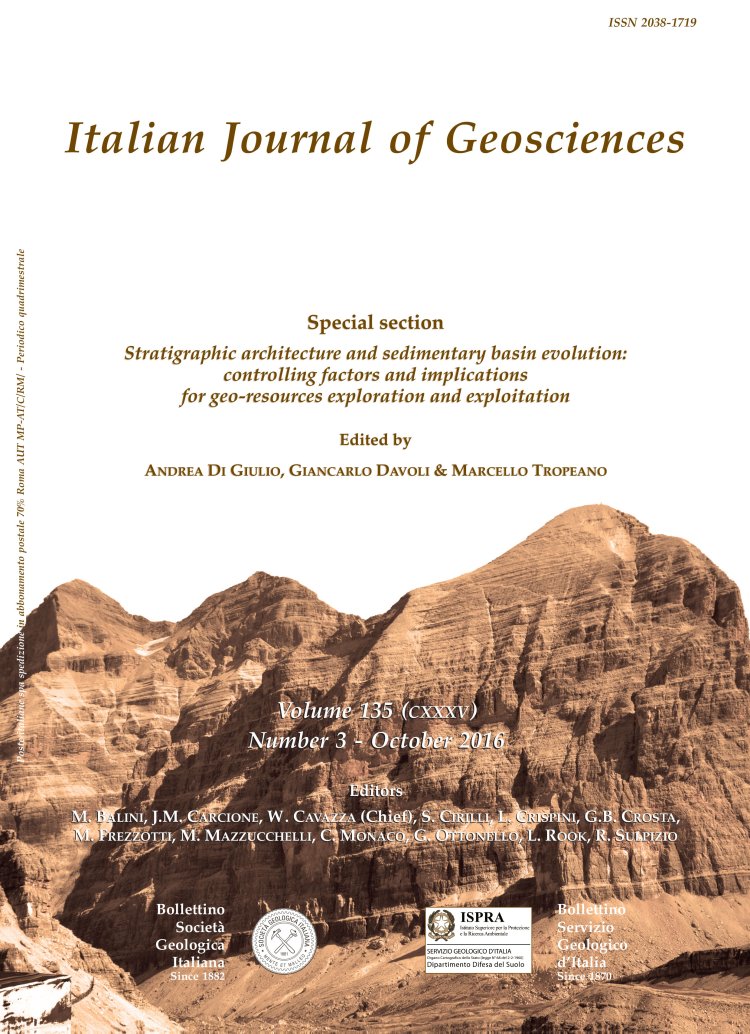
The Friulian-Venetian Basin II: paleogeographic evolution and subsidence analysis from micropaleontological constraints
Nicoletta Mancin (1), Chiara Barbieri (2), Andrea Di Giulio (1), Roberto Fantoni (2), Andrea Marchesini (3), Giovanni Toscani (1) & Adriano Zanferrari (3)
(1) Dipartimento di Scienze della Terra e dell'Ambiente, Università di Pavia, via Ferrata 1, 27100 Pavia, Italy.
(2) ENI E. & P. Division, via Emilia 1, 20097 San Donato Milanese (MI), Italy.
(3) Dipartimento di Chimica, Fisica e Ambiente, Università di Udine, via Cotonificio 114, 33100 Udine (Italy).
Corresponding author: Dr. Nicoletta Mancin, Dipartimento di Scienze della Terra e dell'Ambiente, Università di Pavia, via Ferrata 1, 27100 Pavia, Italy. e-mail: nicoletta.mancin@unipv.it
Phone: 00390382985894; Fax: 00390382985890.
Volume: 135 (2016) f.3
Pages: 460-473
Abstract
During the Cenozoic, the Friulian-Venetian Basin (FVB, NE Italy) underwent a complex evolution, related to the inherited Mesozoic sea-bottom topography and the load exerted by the main tectonic phases which affected the three surrounding belts: the Dinarides to the east, the Southern Alps to the north and the Northern Apennines to the south-west. The study of the foraminiferal assemblages from over 500 samples collected from 13 key wells provides important constraints on the paleobathymetric changes which occurred into the basin through time. Moreover, the defined bathymetric ranges, together with information on both thickness of the different depositional units and depositional geometries (derived from 2D seismic), were used as input in geohistory analysis in order to reconstruct the subsidence/uplift trends occurred in different sectors of the basin, as a response to collisional tectonics acting along basin boundaries.
The collected results show that the overall depositional architecture of the FVB is the result of six main tectono-depositional phases (Lutetian, Chattian, Langhian, Tortonian, Piacenzian and Quaternary) characterised by paleobathymetric variations and subsidence/uplift trends reflecting the change in the tectonic control of the basin and the balance between subsidence and sediment supply. In particular, the easternmost sector of the FVB evolved as a Dinaric foredeep during Lutetian time. Since Chattian time (Cavanella Group), a moderate subsidence phase characterised by faint flexure to the north occurred, which was followed by a Langhian accentuated subsidence phase, consistent with the development of a Southalpine system. The accommodation space was progressively outpaced by the sediment flux during Serravallian-Messinian time as demonstrated by an overall shallowing upward trend recorded in this stratigraphic interval.
A new basin configuration occurred during Piacenzian, when a complex geometry was developed due to the concurrent flexural load of the Southern Alps, to the North, and of the Apennines, to the South. Unlike the previous stratigraphic intervals, the Quaternary sedimentary sequence eventually shows a broadly symmetrical geometry with fast and relatively homogeneous subsidence all over the basin, overbalanced by the sedimentary supply. The observed symmetrical subsidence distribution could be interpreted as a consequence of both vanishing tectonic control and increase of sedimentary input related to increasing climatic variability.
The collected results show that the overall depositional architecture of the FVB is the result of six main tectono-depositional phases (Lutetian, Chattian, Langhian, Tortonian, Piacenzian and Quaternary) characterised by paleobathymetric variations and subsidence/uplift trends reflecting the change in the tectonic control of the basin and the balance between subsidence and sediment supply. In particular, the easternmost sector of the FVB evolved as a Dinaric foredeep during Lutetian time. Since Chattian time (Cavanella Group), a moderate subsidence phase characterised by faint flexure to the north occurred, which was followed by a Langhian accentuated subsidence phase, consistent with the development of a Southalpine system. The accommodation space was progressively outpaced by the sediment flux during Serravallian-Messinian time as demonstrated by an overall shallowing upward trend recorded in this stratigraphic interval.
A new basin configuration occurred during Piacenzian, when a complex geometry was developed due to the concurrent flexural load of the Southern Alps, to the North, and of the Apennines, to the South. Unlike the previous stratigraphic intervals, the Quaternary sedimentary sequence eventually shows a broadly symmetrical geometry with fast and relatively homogeneous subsidence all over the basin, overbalanced by the sedimentary supply. The observed symmetrical subsidence distribution could be interpreted as a consequence of both vanishing tectonic control and increase of sedimentary input related to increasing climatic variability.
Keywords
Get Full Text Supplementary Material